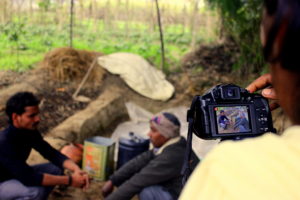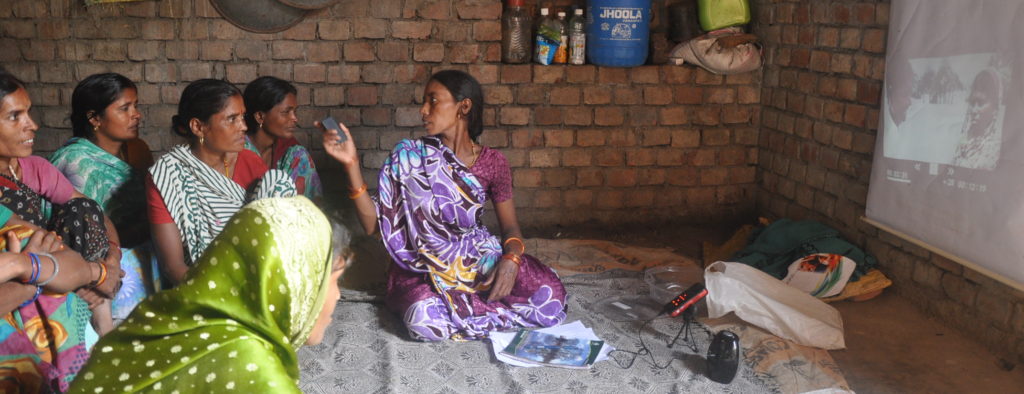Interview with Rikin Gandhi
CEO, Digital Green
Location: Across Asia & sub-Saharan Africa
“Ultimately, lasting impact takes place by changing the story of how farmers see themselves, and helping them realise that they can aspire for a better life for themselves and their families, too.”
Rikin Gandhi is the CEO of Digital Green, a not-for-profit organization focused on improving agriculture, health, and nutrition through the exchange of information among rural communities. Through locally produced videos and facilitated viewing groups, Digital Green reaches approximately 1.4 million people across South Asia and sub-Saharan Africa.
Rikin Gandhi was waiting to hear whether he had been accepted to the United States Air Force, where he wanted to train for a career in space travel, when he made a fateful visit to some friends in India. They had just begun a biodiesel venture, attempting to encourage farmers to grow oil-bearing crops for sustainability. It was Gandhi’s first visit to rural India, and he saw that, while a few farmers were doing well, most were attempting to get out of farming and were hoping to find jobs in the city. Farming is hard work, even under the best of conditions, and these farmers were largely isolated from agricultural research and knowledge of new techniques. He asked himself: what if these rural farmers could share information, cooperatively improving their crop yields?

By the time he was accepted to report to the Air Force’s Officer Training School, Gandhi’s imagination had been captured. Reflecting on his change of heart, he notes the similarity of the two paths; both social entrepreneurship and space travel are mission oriented, but “what’s cool about Digital Green is that we have an open space to learn and develop, to figure out how change is possible. The space track is more well defined.” Talking to Gandhi, one gets the sense that the possibility of continuous experimentation and iteration was irresistible. And that’s exactly what he’s been doing over the last ten years: identifying a problem, testing a solution, rigorously evaluating the results, and experimenting again. In the process, he’s taken a small start-up to impressive heights, all the while questioning, adapting, improving.
In the early days of this project, Gandhi had a chance to connect with some researchers in Microsoft’s Technology for Emerging Markets group in Bangalore who were working with sugarcane farmers in Maharashtra. Computer and Internet access had been provided to connect farmers with information about weather and markets in the late 1990s, but the maintenance cost was prohibitive and the computers ended up being used for basic accounting tasks. But these sugarcane farmers were already more prosperous than most farmers Gandhi had met, causing him to wonder how better access to information might more drastically impact small-scale farmers. He partnered with an NGO outside Bangalore, and they tried many different techniques – posters, audio files distributed by mp3 players, and videos – to facilitate the exchange of information among rural farmers. Gandhi and his partners engaged in a year and a half of quantitative experimentation, analyzing the different ways of distributing information and their results.

The NGO’s traditional approach to training farmers through field demonstrations and exposure visits led by outside external experts in only 10-15% of farmers trying new practices. But through experimentation, Gandhi learned how to boost that number to 70%: local production of information and local dissemination. The technology constraints were significant, but not insurmountable. What was needed as an offline mode of distribution, given the lack of reliable electricity or Internet access.
Digital Green’s solution is rather simple: A handful of local community members are trained to use handheld film equipment to produce videos, and to facilitate the screening among larger community. Using battery-powered, mobile projectors, procured by partners like the Ministry of Rural Development, communities gather and learn of recent improvements in farming techniques. In some of the villages, people have never seen a moving picture before, and so the opportunity to watch a video is a draw.
Gandhi and his colleagues found that when farmers saw people they knew in the videos, or people who were similar to them, they were more engaged and were more likely to try new techniques. They also found that facilitated group screenings worked better than simply broadcasting the programs over television networks. It was the combination of the technology, the local knowledge, and the social networks that stimulated change. By creating a space for conversation within a community, people asked questions and discussed how to try new approaches. And with so many more people adopting the new farming techniques, this technological-social approach was ultimately much more cost effective.
Today, Gandhi is iterating at a much larger scale, now with the Government of India and its large networks of village-level extension agents. With 1.4 million people, 80% of whom are women, now watching these videos, the government wants to know what practices are being adopted and to what effect. The problem he’s working to solve is how best to capture – in Internet-constrained environments – the data the government requires to better target its agricultural development programs. Digital Green has also moved beyond the dissemination of knowledge about farming practices to sharing information about nutrition and health, and to improving transportation logistics by helping farmers get their produce to wholesale markets. And his audience has expanded as well, with a reality TV program and a Facebook game that target middle-class youth to engage with the issues and people of rural India in fun and educational ways. He says, “At some level, you can only do so much to change people’s practices. Ultimately, lasting impact takes place by changing the story of how farmers see themselves, and helping them realize that they can aspire for a better life for themselves and their families too.”

Gandhi notes that involving the Ministry of Rural Development has had a deeper impact on policy as well. As partners in this program, the government is prompted to consider more explicitly what their message is and how and when to deliver this message. In turn, this process of re-evaluating the agricultural program has strengthened the infrastructure and process for the dissemination of information and for collecting data. And in turn, the government is now getting much more feedback from rural farmers about what they need and want. Something as simple as filming a farmer talking about an irrigation technique can compound in its benefits, connecting rural communities to distant agricultural experts, strengthening farming across the nation.
–Erin Martineau, @emmnyc
emartineau.com




